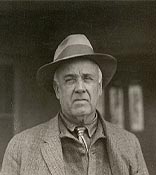 |
The Man The Inventor The Revolutionary |
 |
The Man The Inventor The Revolutionary |
 |
Note: This section contains
transcriptions of newspaper articles that were donated to the Smithsonian Institution (see Source for more details). Many are unattributable and undated. |
|
 |
||
| . . .Ochoa was the inventor of
the Ochoaplane, made by the
International Airship Co. of Paterson, N.J. "His first plane was a glider with folding wings like a bird; the second with an engine was made in 1904," Steve said. Ochoa promoted aviation in general and predicted, "The airship of the future bound on a long journey will rise to the proper height ... And will fly around the earth or half or quarter the way around it, -- regardless of conditions in the atmosphere below." He invented and sold the patents on the adjustable or clincher wrench, patented the electric brake for street cars which he sold to the American Brake Co. in 1907 in Seattle; invented a fountain pen and sold the patent to Waterman Co. in 1900 and patented a pen and pencil clip for holding them in the pocket. He sold that patent to the Americna Pen and Pencil Co. in 1907. Ochoa, whose middle name was Leaton, was born in 1850 in Ojinaga, Mexico, of Spanish and Scotch ancestry. Ben Leaton was Ochoa's grandfather. He was a captain in the Federal Army and settled on the Ochoa's family property. He remodeled an old Spanish mission into a fort and when the government took it over, it was named Fort Leaton. It is located about three miles east of Presidio and five miles west of Presidio is the village of Ochoa Ville. Ochoa's father was Juan Ochoa, who had a large lumber mill in Fort Davis and a large stand of timber in the mountains. He and 20 of his men were ambushed by the Apaches. Victor Ochoa and his brother, Estevan, were boys and were traveling with Juan when the ambush occurred. At the time Mr. Ochoa sought to overthrow the rule of Mexico's chief executive, his family was possessed of considerable landed estate in Chihuahua. Much of this had been seized in the early nineties. Of great note were the activities of the regular soldiery uprising that was started by Mr. Ochoa. He picked a band of several hundred men about him and started a revolt that stirred the entire Republic. During one of his marches he was caught in the mountain fastnesses by Diaz's soldiers and hemmed in on all sides. He saw his men put up a gallant fight, but outnumbered, they fell one by one until Mr. Ochoa alone survived. Through a ruse he managed to obtain the uniform of one of the regular soldiers and while on the retreat was espied and shot at in the belief that he was a deserter. Then started a chase which led through the mountain fastnesses, through treacherous ravines and gullies. It was a long traverse over three hundred miles, but the plucky Ochoa, finally managed to obtain some aid and eluded his pursuers. He went to Texas where he remained in exile for a long time while President Diaz's men were hunting for him spurred on by the big reward. The Mexican government offered $50,000 in gold as reward for Ochoa. He went to Fort Stockton to avoid bounty hunters but finally gave himself up to Fox, head of the Texas Rangers. He was brought back to El Paso, tried and sent to the Federal prison in New York. However, once in New York, his friend Teddy Roosevelt worked for a reduced and finally, suspended sentence. Many years later, he went into partnership with two men who offered to help him enlarge his gold mine production. Ochoa fell ill and the two men took his gold and horses, leaving him to die at El tambora, Sinoloa, Mexico. After he recovered, he returned to El Paso. "I think it was about 1936," Steve Ochoa said. "He was walking down the street with the chief of police, when he saw the men. They drew first, but Ochoa, who was unarmed, grabbed the chief's gun and shot both. The chief took him to the judge. "The judge agreed Ochoa had cause to fire, but inasmuch as the men were from influential families, he was advised to go back to Mexico." Ochoa had married Amanda Cole, granddaughter of Thomas Cole, the American painter, whose most famous painting is The Last of the Mohicans. Ochoa returned to Sinaloa, Mexico, after the 1936 shooting and it is believed he died there in 1945. Estevan Ochoa's son, Victor Ochoa, is the sheriff in Fort Hancock.
|
||